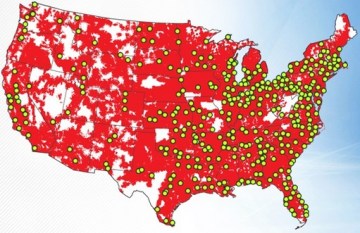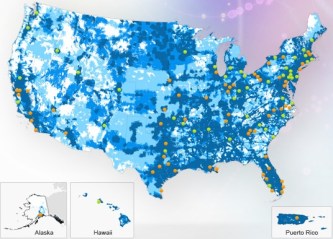When Apple announces its new iPhone next week, there’s a good chance it’ll support 4G LTE data speeds. If that happens, we’ll surely hear all about it from wireless carriers eager to extol their own gloriously fast networks.
But as this happens, it’s worth noting that 4G data is still a work in progress. That may explain why Apple has held off on the technology for so long, even as Android and Windows Phone handsets have adopted it. Wireless carriers in the United States aren’t nearly finished rolling out their faster networks, so while the new iPhone may support 4G LTE, that doesn’t necessarily mean you’ll get faster speeds in your area.
With that in mind, below is a rundown on the state of 4G LTE for all four major wireless carriers, and how to find out if you’re covered. (You may also want to read Doug Aamoth’s refresher on what “4G” actually means. The short version is that 4G LTE has the fastest theoretical maximum speeds compared to HSPA+ and WiMax, and it’s the standard that all U.S. wireless carriers are now moving toward.)

Verizon
Verizon Wireless
In late 2010, Verizon became the first U.S. carrier to launch its 4G LTE network, so naturally it has the biggest jump on its competitors. That’s evident in Verizon’s 4G LTE coverage map (shown here in green dots), which covers a pretty large swath of the United States. The carrier says its 4G LTE is available in 371 cities, and covers 75 percent of the U.S. population. Verizon plans to have at least 400 markets covered by the end of the year.
The downside with Verizon is that if you’re not in a 4G LTE coverage area, you’ll get much slower 3G speeds. That’s not the case with AT&T, as I’ll explain shortly. But as Verizon covers more of the country with its new network, the fallback to 3G becomes less of a problem.

AT&T
AT&T
AT&T started rolling out its 4G LTE service about a year ago, but it’s still far behind Verizon with only 53 markets online so far. The good news is that the carrier is tacking on another 40 markets by the end of the year.
AT&T’s saving grace is its use of HSPA+, which is basically acts like a turbo version of 3G in many areas where there’s no LTE coverage. (AT&T has referred to HSPA+ as “4G” in its marketing, which I find misleading). Although HSPA+ isn’t as fast as LTE, it is a bit easier on battery life. The dots in AT&T’s coverage map here show LTE, and the darkest blue areas show HSPA+.
The iPhone 4S already supports a low-speed version of HSPA+ on AT&T, which is why those devices now show a 4G logo–again, misleading–but I’m guessing even the fallback to HSPA+ will be faster in Apple’s next iPhone.

Sprint
Sprint
Sprint previously sold “4G” phones using a different standard, called WiMax, but the carrier is now scrapping that network in favor of 4G LTE. As such, the carrier is just getting started on 4G LTE with 19 cities covered so far. Even if 4G LTE is supported in the next iPhone, the vast majority of Sprint subscribers won’t be able to enjoy it right away. (To look up coverage areas on Sprint’s website, you must click “Sprint 4G LTE” under the “Data coverage” section.)
One other thing: Sprint’s 4G LTE network isn’t as fast as those of AT&T and Verizon, due to its use of narrower frequencies. And like Verizon, the 3G network you fall back to is much slower.
T-Mobile
T-Mobile will be the latest of the major carriers to join the 4G LTE party, with no rollout plans until 2013. The carrier has relied on HSPA+ instead, which is slower than LTE but doesn’t cause as big of a hit in battery life. Not that it matters for the next iPhone, which T-Mobile isn’t expected to get. (T-Mobile may, however, sell SIM cards for the unlocked iPhone 4 and iPhone 4S that support HSPA+.)
Now, even if you have 4G LTE in your area, there’s still the issue of what speeds you can expect. That can vary depending on network congestion and other factors, and wireless carriers tend to advertise what you’d ideally get (“speeds up to 10 times faster than 3G” is a common refrain), not what you can realistically expect.
The Federal Communications Commission is just starting to run its own speed tests, with the hope that carriers will be more honest about data speeds.
MORE: Ask Techland: What’s the Deal with 4G? Is the New iPhone 4G?

